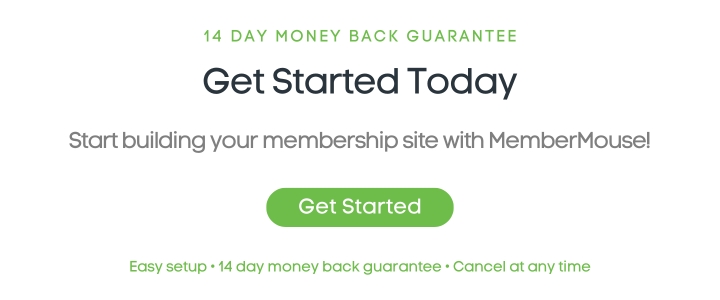Creating An Engaging Content Delivery Strategy
I recently published an article titled the 3 Secrets of Profitable Membership Sites. In that post I revealed certain trends and themes I’ve noticed over the years among our customers who build successful, profitable membership sites compared to those who don’t.
One of the factors that distinguishes a successful membership site from an unsuccessful one is a strong focus on customer experience. For membership sites that are built around access to exclusive content, it would seem obvious that creating high quality content would be of the utmost importance. However, what is less obvious is the need to plan out the way you organize and deliver your content.
The reason I bring this up is because I was asked the following question in response to my ‘3 Secrets’ article:
“I hadn’t really considered the “content delivery strategy” of my site. I guess I never really thought of it as being so overwhelming to have everything out there, and that’s something I might need to look into. Do you have suggestions of how to know what to put where/when? Thanks!”
So, I thought I’d create another post outlining an approach you can use to organize and deliver the content you create for your membership site.
Let’s dig in.
1. Understand Your Objective
The most important step is the first one: understand your objective.
Ask yourself, “What do I want people to have learned after going through my course?” Starting from this point, you can then reverse engineer the steps you would take to get to that level of understanding starting from square one.
For example, if the final objective of your course is to successfully ‘plant a tree’, some of the steps you might need to take are: how to choose a hospitable environment, where to buy the seeds, how to water the seeds, etc.
When you start with the outcome you are helping your customer achieve, the steps for getting there should become clear. Once you have a clear idea of each one of the steps the person going through your content needs to take, you'll have a good idea about how to structure your course.

2. Start Broad, Then Get Specific
From there, the next step is to determine how you will divide up and organize your content. At first, keep the steps at a high-level. These will eventually become the sections within your course. Once you feel like you have all the high-level sections, drill down into each one and bullet-point out the major components that make it up. These will be your individual lessons.
Once you have identified the major sections and lessons of your content, place them in logical order (i.e. in order to understand how to water a seed you first need to know how to bury it in soil, etc.). The natural order should come out easily. However, if the natural order doesn’t come out easily you may have a lesson or section that includes too many concepts… That’s when you know it’s time break it down further. Remember, you want to make it simple and easy for your customers to progress through your content.
If you're getting stuck with how to organize your content, you might be falling into a trap we see all the time with subject matter experts: assuming your customers know more about your subject than they actually do.
3. Don’t Assume Knowledge
When you're going through this process, it’s vitally important not to assume that people know what you know. Get into the mindset of someone who’s starting with a blank slate in your area of expertise. It’s easy to tell when someone makes this mistake when authoring a course because as a student you’ll feel overwhelmed and lost. This is because the proper foundation wasn’t built for you.
As an expert in your field, not assuming knowledge can be tough because you’ve been doing what you do for so long that it has become second nature. So, if you’ve been planting trees for a long time you may make the assumption that everyone knows that trees come from a seed and that seeds need to be watered.
To accommodate for this blind spot, it’s a good idea to have 2 or 3 test subjects go through your course and let you know if and when they get lost (the closer these test subjects are to your average customer the better). Once you've gotten some feedback from these test subjects, you can make the appropriate modifications to your content.

4. Create a Quick Start Guide
Once you have your course plan finalized, it’s a good idea to create a Quick Start Guide. The great thing about a Quick Start Guide is that it’s a low effort, high-impact asset. You’ve already done the hard work of creating all of the content, now you’re just repurposing it to help your customers get started.
Your Quick Start Guide should give the customer an overview of your course and present it in a way that will get them excited about going through it. It should also allow them to accomplish something tangible and meaningful within a short period of time. People like to experience results and the sooner they’ve achieved something through your content, the more naturally they’ll be motivated to complete your entire course.
For instance, you could teach them the ‘First 3 steps to planting a tree’, have them take a quiz on the material and then give them some kind of reward for completing (this could just be a page that says congratulations and has a certificate that they can print out). This particular example is kind of silly, but the concepts of quickly demonstrating your value and rewarding the customer for taking action are very powerful.
Next we'll take a look at creating an engaging content delivery system that doesn't overwhelm your customers with a deluge of content.
5. Implement Your Content Delivery Strategy
Now you have a course with a quick start guide, major sections and individual lessons arranged in a logical order. From here implementing your content delivery schedule, or drip content sequence, is easy (assuming you have the right membership solution). The main thing to consider is exactly how much time you want to place in between your lessons.
Here's a example of how you could structure your tree planting course: The Quick Start Guide and lesson 1 are available on day 1, lesson 2 is available on day 4, lesson 3 on day 6, etc.
Choosing the length of time between lessons is completely up to you and should really be based on how your customers interact with your content. If you know that most of your customers on average need 3 days to complete lesson 2, you could schedule lesson 3 to become available accordingly. Keep in mind that you want to find the balance between keeping your customers engaged and overwhelming them with too much content.
That leads us to our final step in creating a content delivery system.
6. Keep Customers Engaged
When new lessons become available on your site, it’s a good idea to send out a notification email. This will ensure that your customer stays engaged with your content. When customers are engaged, they are far more likely to participate in the social aspects of your site. This increases both member retention and customer loyalty.
Without notifications from your site, your members may not login for 2 weeks or more. When they do come back to your site and find they have a pile of 6 lessons to complete, they may feel overwhelmed and be prompted to cancel their membership. Overwhelming your members with too much content is a real problem. But, by intelligently designing a content delivery system that encourages engagement, you're proactively taking steps to help your members achieve success with your content.

Wrapping Up
By now, it should be clear that having a well-formulated content delivery strategy is a great way to keep your members engaged with your site and ensure their success with your content. When you know what it is that you are trying to help your customers achieve and where they currently are in relation to that goal, it’s easy to map out the steps they need to take to get there. From there, you can use this information to organize your content in a way that’s easy for them to digest.
With drip scheduling, you can literally walk your customer through each step they need to take, and ensure they aren’t overwhelmed with too much content and information off the bat. When you help your customers get some quick-wins, they’ll be more likely to stick with your program and achieve success with your content. All of this increases your chances of retaining your members and building a stable recurring revenue stream with your membership site.
If you are interested in a deeper dive into this area, I suggest that you listen to my upcoming podcast with Ali Jafarian – a developer with over 10 years of experience designing and developing world-class membership sites. I'll be publishing the episode on Tuesday next week, so until then you can subscribe to our podcast on iTunes and check out previous episodes here.
Eric Turnnessen
Eric Turnnessen is the founder of MemberMouse. His absolute dedication to quality and insistence on perfection have made MemberMouse the premier WordPress membership plugin on the market today. His attention to detail and commitment to continual improvement make MemberMouse the #1 choice for business owners looking for a reliable and scalable membership solution.
 Blog
Blog Podcast
Podcast Support
Support Customer Login
Customer Login









